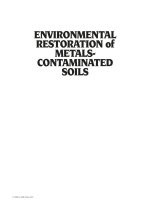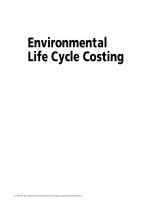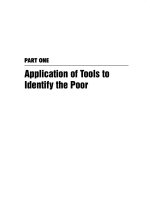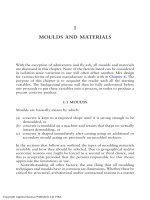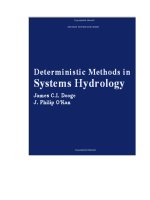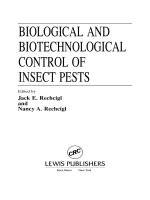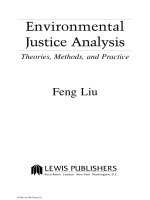Environmental Risk Assessment Reports - Chapter 1 pdf
Bạn đang xem bản rút gọn của tài liệu. Xem và tải ngay bản đầy đủ của tài liệu tại đây (739.22 KB, 42 trang )
A Practical Guide to
Understanding, Managing,
and Reviewing
Environmental
Risk Assessment
Reports
© 2001 by CRC Press LLC
A Practical Guide to
Understanding, Managing,
and Reviewing
Environmental
Risk Assessment
Reports
Edited by
Sally L. Benjamin
David A. Belluck
LEWIS PUBLISHERS
Boca Raton London New York Washington, D.C.
© 2001 by CRC Press LLC
LA4111/frame/FM Page 2 Thursday, December 28, 2000 2:09 PM
Library of Congress Cataloging-in-Publication Data
A practical guide to understanding, managing, and reviewing evironmental risk
assessment reports / Sally L. Benjamin, David A. Belluck, editors.
p. cm.
Includes bibliographical references and index.
ISBN 1-56670-448-0 (alk. paper)
1. Environmental risk assissment. I. Benjamin, Sally. II. Belluck, David.
GE145 .P73 2000
333.7′14—dc21
00-048667
This book contains information obtained from authentic and highly regarded sources. Reprinted material
is quoted with permission, and sources are indicated. A wide variety of references are listed. Reasonable
efforts have been made to publish reliable data and information, but the author and the publisher cannot
assume responsibility for the validity of all materials or for the consequences of their use.
Neither this book nor any part may be reproduced or transmitted in any form or by any means, electronic
or mechanical, including photocopying, microfilming, and recording, or by any information storage or
retrieval system, without prior permission in writing from the publisher.
All rights reserved. Authorization to photocopy items for internal or personal use, or the personal or
internal use of specific clients, may be granted by CRC Press LLC, provided that $.50 per page
photocopied is paid directly to Copyright Clearance Center, 222 Rosewood Drive, Danvers, MA 01923
USA. The fee code for users of the Transactional Reporting Service is ISBN 1-56670-4480/01/$0.00+$.50. The fee is subject to change without notice. For organizations that have been granted
a photocopy license by the CCC, a separate system of payment has been arranged.
The consent of CRC Press LLC does not extend to copying for general distribution, for promotion, for
creating new works, or for resale. Specific permission must be obtained in writing from CRC Press LLC
for such copying.
Direct all inquiries to CRC Press LLC, 2000 N.W. Corporate Blvd., Boca Raton, Florida 33431.
Trademark Notice: Product or corporate names may be trademarks or registered trademarks, and are
used only for identification and explanation, without intent to infringe.
Visit the CRC Press Web site at www.crcpress.com
© 2001 by CRC Press LLC
Lewis Publishers is an imprint of CRC Press LLC
No claim to original U.S. Government works
International Standard Book Number 1-56670-448-0
Library of Congress Card Number 00-048667
Printed in the United States of America 1 2 3 4 5 6 7 8 9 0
Printed on acid-free paper
© 2001 by CRC Press LLC
LA4111/frame/FM Page 3 Thursday, December 28, 2000 2:09 PM
Dedication
To our fathers, Louis Belluck and Norton James Benjamin, for their love of
books.
© 2001 by CRC Press LLC
LA4111/frame/FM Page 5 Thursday, December 28, 2000 2:09 PM
Acknowledgments
We wish to thank the 31 other professionals, who shared our vision of a comprehensive, general guide to environmental risk assessment, for their dedication to
the idea and for their patience as our manuscript went through several iterations.
We owe special thanks to Ruth Hull, who gave freely of her ideas, professional
contacts, and support. Without her, this book would not have been possible. We
thank our peer-reviewers and readers, most especially Dr. Hiai Rothmann. We also
acknowledge the contribution of Steven David, who has successfully implemented
many of the ideas in this book.
© 2001 by CRC Press LLC
LA4111/frame/FM Page 7 Thursday, December 28, 2000 2:09 PM
Disclaimer
Extreme care has been taken in preparation of this work. However, neither the
publisher, editors, nor authors shall be held responsible or liable for any damage
resulting in connection with or arising from the use of any of the information in
this book.
© 2001 by CRC Press LLC
LA4111/frame/FM Page 9 Thursday, December 28, 2000 2:09 PM
Contributors
George Anderson, B.A., M.A., C.H.M.M., is the Director of Environmental
Compliance & Safety at US Filter Recovery Services Inc., 2430 Rose Place,
Roseville, Minnesota 54701, one of Minnesota's largest hazardous waste recycling,
treatment, and storage facilities. Mr. Anderson has a Bachelors degree in Biology
and Chemistry and a Master’s degree in Biology from St. Cloud State University.
Mr. Anderson has 29 years of professional experience in industry, consulting, government, and utilities. He currently serves as the President of the Minnesota Chemical Technology Alliance, the Chemical Manufacturers Association, State of Minnesota Affiliate. Mr. Anderson has testified on hazardous waste management issues
before the Wisconsin State Legislature, the Minnesota Waste Management Board,
and has represented the waste management industry before the U.S. EPA and the
U.S. Congress.
Carol Baker, M.S., M.A. is Senior Consultant at ENTRIX, Inc., 5252 Westchester, Suite 250, Houston, Texas 77005. She is Manager of Environmental Sciences
and, for the past 10 years, she has worked in human health risk assessments under
CERCLA, RCRA, UST and Voluntary Cleanup Programs. Ms. Baker earned her
Bachelor of Arts degree in Wildlife Management from North Carolina State University, a Master of Science in Fisheries Science/Aquaculture from Louisiana State
University, and a Masters of Arts in Science Education from North Carolina State
University.
David A. Belluck, B.S., Ph.D., is a toxicologist and risk assessor with more
than 30 years experience in public health and environmental science. Dr. Belluck is
principal toxicologist for Risk Writers, Ltd., 3108 46th Avenue South, Minneapolis,
Minnesota 55406. Dr. Belluck provides expert services for litigation in the areas of
toxicology, environmental risk, and the history of science. Dr. Belluck publishes
extensively on risk assessment, toxicology, and groundwater protection. His current
research interests include historical toxicology of manufactured gas plants and
improved project management techniques for risk assessment and public decisionmaking. He is a member of the National Advisory Committee to the U.S. EPA on
Ambient Exposure Guideline Levels (AEGLs). Dr. Belluck earned his Bachelor of
Science degree from Cornell University and his Ph.D. from the University of Illinois.
Sally L. Benjamin, M.S., J.D., is an environmental scientist and attorney with
more than 25 years of professional experience in environmental policy, natural
resources management, and public dispute resolution. Ms. Benjamin’s firm, Risk
Writers, Ltd., 3108 46th Avenue South, Minneapolis, Minnesota 55406, conducts
historical and technical research for environmental litigation and provides expert
services in toxicology, environmental science, and the history of science. Ms. Benjamin earned her Bachelor of Arts in Biology, Mansfield State College, Pennsylvania,
her Master of Science from the Institute for Environmental Studies, University of
Wisconsin-Madison, and her Juris Doctorate from the University of Minnesota. She
is a member of the Hennepin County Bar and of the Minnesota and the Wisconsin
State Bar Associations. Her research interests include environmental impacts of local
land use planning, interrelationships of transit, traffic and urban air quality, manu-
© 2001 by CRC Press LLC
LA4111/frame/FM Page 10 Thursday, December 28, 2000 2:09 PM
factured gas plant history, and the role of environmental science in litigation, public
policy, legislation, and regulation.
Bruce Braaten, P.E., J.D., works for the Minnesota Pollution Control Agency
in Winona, Minnesota, and he teaches environmental law at the University of Minnesota. Mr. Braaten earned his Juris Doctorate from the William Mitchell School of
Law and his Bachelor of Science and Master of Science degrees in engineering from
the University of Minnesota.
Jan W. Briede, Ph.D. (New Mexico State University) is a biologist with Dames
& Moore, 644 Linn Street, Suite 501, Cincinnati, Ohio 45203. He has more than
20 years of experience in ecology and ecosystem modeling world-wide (Africa, the
Middle East, Asia, Europe, and the U.S.). Presently, Dr. Briede supports clients in
fields such as: project management, ecological risk assessments, decision support
systems, ecological inventories, wetland issues, ecosystem restoration, permitting,
and environmental site assessments.
Gary J. Burin, Ph.D., D.A.B.T., Associate Director of the Toxicology Division,
Technology Sciences Group, Inc., 1101 17th Street, N.W., Suite 500, Washington,
D.C. 20038, earned his Bachelor of Science in Biology and M.P.H. in Toxicology
from the University of Michigan and his Ph.D. in Biology, with a Pharmacology
minor, from George Washington University. He coordinated much of the international work surrounding OECD, WHO and the EC, particularly the harmonization
of data requirements, study interpretation, and risk assessment. Dr. Burin authored
the WHO document, “Environmental Health Criteria Document 104 — Principles
for the Toxicological Assessment of Pesticide Residues in Food,” and the U.S. EPA’s
“Standard Evaluation Procedures” for the evaluation of chronic reproductive and
developmental toxicity studies. He has served on national committees under the
National Toxicology Program and the Office of Science and Toxicology and has
lectured at the Universities of Sienna, Italy, and Surrey, England, as a Diplomate of
the American Board of Toxicology.
Rick D. Cardwell, Ph. D., Parametrix, Inc., 5808 Lake Washington Blvd. N.E.,
Kirkland, Washington 98052, is an ecotoxicologist with 30 years experience studying
the fate and effects of chemicals and wastes in the environment. He has authored
dozens of ecological risk assessments, including two primers on ecorisk assessment
methodologies.
Robert Craggs, M.S., J.D., is Senior Director of Environmental Services for
R.W. Beck, Minneapolis Office, 1380 Corporate Center Curve, Suite 305, St. Paul,
Minnesota 55121. Mr. Craggs earned his Juris Doctorate and Master of Science
degrees from the University of Iowa.
John P. Cummings, Ph.D., C.H.M.S., R.E.A., R.E.P., J.D., P.O. Box 2847,
Fremont, California 94536, is a chemist, environmental engineer, teacher, and
attorney with over 30 years of experience in environmental project management,
remedial design, and implementation of environmental programs and policies. He
has a strong background in hazardous/toxic waste management, UST work, including pollution abatement implementation, solid waste management, resources
recovery and recycling, asbestos assessment, lead audits and clean-up, and legal
aspects of OSHA and U.S. EPA litigation and product liability. He also has an
© 2001 by CRC Press LLC
LA4111/frame/FM Page 11 Thursday, December 28, 2000 2:09 PM
extensive technical background in chemistry, ceramic, paper, and plastic materials.
He is a patentee and author of more than 40 papers.
Maxine Dakins, Ph.D., is an Assistant Professor of Environmental Science at
the University of Idaho, Idaho Falls, Idaho, 83402. Dr. Dakins teaches courses in
uncertainty analysis, the sampling and analysis of environmental contaminants, and
natural resources policy. Her research interests include various aspects of uncertainty
analysis including Bayesian Monte Carlo Analysis and uncertainties related to measuring contaminants at trace levels.
Clifford S. Duke, M.A., Ph.D., a Senior Environmental Analyst at The Environmental Company, Inc., 1611 North Kent Street, Suite 900, Arlington, Virginia
22209, earned his Bachelor of Science degree in Biology at the University of Vermont
and graduate degrees in public policy analysis (M.A.) and botany (Ph.D.) at Duke
University. He has prepared ecological risk assessments and managed National
Environmental Policy Act documents for Department of Energy and Department of
Defense facilities nationwide. Dr. Duke is a past-president of the Ohio Valley Chapter
of the Society of Environmental Toxicology and Chemistry and is an active participant in risk assessment standardization efforts of the American Society for Testing
and Materials.
Nava C. Garisto, Ph.D., is Senior Scientist at SENES Consultants Limited, 121
Granton Drive, Unit 12, Richmond Hill, Ontario, Canada L4B 3N4. Dr. Garisto has
20 years of scientific and consulting experience and has published more than 60
journal publications and reports relating to environmental model development, mass
transport of radionuclides and toxic contaminants and environmental risk assessment.
Guy L. Gilron, M.Sc., R.P.Bio., is a Senior Project Manager (Ecotoxicology)
with ESG International Inc., 361 Southgate Drive, Guelph, Ontario, Canada, N1G
3M5. Mr. Gilron has conducted environmental effects assessment of natural
resources in North America, the Caribbean, South America, and the Middle East.
Moreover, he has conducted ecotoxicological valuations in large- and small-scale
environmental programs. He is an experienced environmental biologist, with a focus
on aquatic toxicology and ecology, and with expertise in ecological risk assessments,
aquatic community structure analyses, toxicological research, ecological inventories,
and water quality assessments for aquaculture.
Michael E. Ginevan, Ph.D., is president of M.E. Ginevan & Associates, 307
Hamilton Avenue, Silver Spring, Maryland 20901. Dr. Ginevan’s firm provides
interdisciplinary statistical consultation for the health and environmental sciences.
301-585-4951; Fax: 301-585-1350; e-mail: or
Laura C. Green, Ph.D., D.A.B.T., is a Senior Scientist and President of Cambridge Environmental, Inc., 58 Charles Street, Cambridge, Massachusetts 02141,
and Lecturer in the Division of Toxicology at the Massachusetts Institute of Technology. Dr. Green has performed original research, published, and consulted in the
areas of chemical carcinogenesis, toxicology and pharmacology, food chemistry,
analytical chemistry, risk assessment, and regulatory policy. Prior to founding Cambridge Environmental, Dr. Green was Senior Vice President at Meta Systems Inc.
and the founder and director of Meta’s Environmental Health and Toxicology group.
© 2001 by CRC Press LLC
LA4111/frame/FM Page 12 Thursday, December 28, 2000 2:09 PM
She also served as Research Director of the Scientific Conflict Mapping Project at
the Harvard University School of Public Health, during which time she coauthored
the text, In Search of Safety: Chemicals and Cancer Risk. Dr. Green currently
specializes in: performing qualitative and quantitative assessments of health and
environmental risks; providing toxicologic and other technical expertise designed to
aid in regulatory compliance and in decision-making; providing and directing scientific support for litigation and other matters; and teaching toxicology. Dr. Green
holds a B.A. from the Department of Chemistry at Wellesley College (1975) and a
Ph.D. from the former Department of Nutrition and Food Science (currently the
Division of Bioengineering and Environmental Health) at the Massachusetts Institute
of Technology (1981). She is a diplomate of the American Board of Toxicology
(D.A.B.T.).
Carol “Griff” Griffin, M.S., Ph.D., is an Assistant Professor in Natural
Resources Management at Grand Valley State University, 218 Padnos Hall, Allendale, Michigan 49401-9403. Professor Griffin teaches courses in natural resource
policy, water resources, environmental policy, environmental science, and environmental ethics. Her research interests include public participation in natural resource
management, nonpoint source pollution modeling, and the role of error in GIS
modeling. Dr. Griffin earned her M.S. and Ph.D. in Environmental Science from the
State University of New York — College of Environmental Science and Foresty.
Donald R. Hart, M.S., Ph.D., Senior Ecologist at Beak International Incorporated, 14 Abacus Road, Brampton, Ontario, Canada, L6T 5B7, has 15 years of post
doctoral research and consulting experience and over 30 journal publications and
reports in aquatic ecology, ecotoxicology, and ecological risk estimation. Dr. Hart
earned his Ph.D. in Environmental Biology from Tulane University and both his
Master of Science and Bachelor of Science degrees in Zoology from the University
of Manitoba.
Ruth N. Hull, M.Sc., is a Risk Assessment Specialist at CANTOX ENVIRONMENTAL INC., 2233 Argentia Road Suite 308, Mississauga, Ontario, Canada, L5N
2X7. Ms. Hull earned a Masters of Science in Ecotoxicology from Concordia
University and a Bachelor of Science in Biology from the University of Waterloo,
Waterloo, Ontario. Ms. Hull oversaw contractor-produced risk assessment reports
while working for the State of Minnesota's Pollution Control Agency and Oak Ridge
National Laboratory (ORNL). She has been the lead ecological risk assessor on
several risk assessments for contaminated sites across North America.
Colleen J. Dragula Johnson, M.S., D.A.B.T., 5815 Redford Drive, #E, Springfield, Virginia 22152, provides general toxicology services relating to the Food and
Drug Administration and the U.S. EPA, including summarizing toxicity data for
investigation of new drug applications.
Wendy Reuhl Jacobson, B.S., M.S., of Colorado Springs, Colorado, earned her
degrees in Natural Resources from the University of Wisconsin in poultry genetics
and in Natural Resources Management from the University of Alaska, Fairbanks,
where she investigated the readability and graphic content of federal environmental
impact statements. Ms. Jacobson’s research article, "The Typography of Environmental Impact Statements: Criteria, Evaluation, and Public Participation" was published in Environmental Management in January 1993.
© 2001 by CRC Press LLC
LA4111/frame/FM Page 13 Thursday, December 28, 2000 2:09 PM
Robert A. Kreiger, M.S., Ph.D., 9414 North 84th Street, Stillwater, Minnesota
55082, earned his Master of Science Degree in Epidemiology from the University
of Michigan and a Doctor of Philosophy in Environmental Health from the University
of Minnesota. Dr. Kreiger has over a decade of experience in risk assessment and
has conducted epidemiological studies of worker cohorts and residential populations,
and has researched the use of chromosomal damage biomarkers to characterize
occupational and public exposures and the use of immunoassay methods for screening worker exposure to pesticides.
Jeanette H. Leete, Ph.D., is the Supervisor of the Technical Analysis Group in
the Ground Water Unit of the Minnesota Department of Natural Resources in St.
Paul Minnesota 55155. Dr. Leete is a Licensed Professional Geologist in the State
of Minnesota, a certified Professional Hydrogeologist (American Institute of Hydrology) and a Certified Professional Geologist (American Institute of Professional
Geologists). Dr. Leete received her doctoral degree from the University of Minnesota.
Kathy Malec, M.S., is an environmental librarian with more than a decade of
experience in technical library research. Ms. Malec earned her Master of Science
degree in Library Science from the University of Minnesota. She is a Librarian/Information Specialist with the Minnesota Pollution Control Agency and has worked as
a librarian for private consulting firms and in academia, prior to entering state service.
Wayne Mattsfield, B.S., has over a decade of professional experience in state
government, as a Minnesota Department of Health environmental laboratory analyst,
laboratory certification officer and quality assurance officer, and Minnesota Pollution
Control Agency quality assurance coordinator for federal and state Superfund sites.
Mr. Mattsfield earned his Bachelor of Science degree in Biology, with emphasis in
Microbiology, from St. Cloud State University. Mr. Mattsfield is currently in private
consulting and can be reached at 16123 Harvard Lane, Lakeville, Minnesota 55044.
William Phillips, B.A., M.S., is Senior Project Director & General Manager,
Environmental Strategies Corporation, 123 North 3rd Street, Suite 706, Minneapolis,
Minnesota 55401. Mr. Phillips is widely experienced in environmental and regulatory
toxicology, risk assessment, environmental claims, investigation and remediation of
hazardous waste sites, environmental fate and transport, and evaluation of environmental impairment. He earned his Master of Science in Environmental Toxicology
from the University of Minnesota and his Bachelor of Arts degree in Biology and
History from Macalester College. He publishes in environmental remediation and
provides expert services for environmental litigation.
Mark W. Rattan, J.D., is an attorney with Litchfield Cavo, 303 West Madison
Street, Suite 200, Chicago, Illinois 60606. Mr. Rattan practices insurance coverage
and insurance defense litigation. He earned his Juris Doctorate from Loyola University. He is licensed to practice in Wisconsin and Illinois. He is a member of the
State Bar of Wisconsin, the Chicago Bar Association, and the Milwaukee Bar
Association.
Bruce T. Rodgers, M.Sc., P.Eng., Senior Environmental Engineer, Beak Consultants Limited, 14 Abacus Road, Brampton, Ontario, Canada, L6T 5B7. Mr.
Rodgers specializes in the analysis of natural receiving water systems. He has been
involved extensively in environmental impact assessments, numerical model studies,
and field monitoring planning for marine and freshwater environments. In particular,
© 2001 by CRC Press LLC
LA4111/frame/FM Page 14 Thursday, December 28, 2000 2:09 PM
Mr. Rodgers has been involved in the application and interpretation of multi-dimensional numerical models for predicting physical, hydraulic, thermal, and water quality characteristics of receiving waters. He earned his Bachelor of Science in Geotechnical Engineering from the University of Toronto and his Master of Science in
Coastal Engineering from Queen’s University.
Richard A. Rothstein, C.C.M., Q.E.P., is Senior Air Quality Consultant for
RAR Associates, 46 Liberty Street, North Andover, Massachusetts 01845. Mr. Rothstein earned his Bachelor of Science in Meteorology from Rutgers University, and
his Master of Science in Meteorology and Air Resources Engineering from New
York University. He has more than 25 years of diversified project management and
technical expertise in air quality impact assessment; environmental pollution control
and permitting; facility siting and design; and regulatory review, compliance planning and agency negotiation for waste processing, power generation, and industrial
projects.
Bradley E. Sample, Ph.D., is a Senior Wildlife Toxicologist and Ecological Risk
Assessor with CH2M HILL (2485 Natomas Park Dr., Suite 600, Sacramento, California 95833). Dr. Sample holds a Bachelor of Science in Wildlife Biology from
West Virginia University, a Master of Science degree in Entomology from the
University of Delaware, and a Doctorate of Philosophy in Wildlife Toxicology from
West Virginia University. Dr. Sample has more than a decade of experience in wildlife
toxicology and ecological risk assessment emphasizing development of models and
methods for estimation of bioaccumulation, exposure, and effects in birds and
mammals, as well as other ecological receptors.
David Weitz is a Public Affairs Manager with the Wisconsin Department of
Natural Resources, N902 910th St., Mondovi, Wisconsin 54755. Mr. Weitz worked
for thirteen years as a newspaper reporter. During more than two decades as a public
information officer and public affairs manager he has managed communications on
numerous emergency response efforts, including large train derailments, massive
tire fires, and chemical releases. He has served as information officer for the Wisconsin Law Enforcement Task Force on tribal fishing and for the U.S. Forest Service
on major forest fires and Texas Forest Service in emergency fire prevention programs.
Jeanne C. Willson, Ph.D., D.A.B.T., M.B.A, is a toxicologist with her own firm,
Global Environmental Strategies, P.O. Box 3492, Englewood, Colorado 80155,
Dr. Willson earned her Ph.D. at Cornell University and her M.B.A. (International Business) at the University of Colorado,
Denver. She has over 15 years of experience in toxicology, chemical safety, risk
assessment, and risk management. Her work at mining, smelting, and metals disposal
sites has included metals risk assessment, blood lead and urinary arsenic studies,
metals bioavailability, IEUBK (lead) model evaluation and application, plant uptake
of metals, quantitative uncertainty analysis, and evaluation of ecological benchmarks
and measurements. She is also experienced in radiological risk assessment (especially radon), air emissions and deposition modeling, groundwater quality, and
carcinogen risk assessment. Dr. Willson has managed or reviewed hundreds of human
health and ecological risk assessments of hazardous waste and occupational chemical
exposure at Superfund and RCRA sites and operating facilities of all types, including
landfills and incinerators. Her interest in international environmental policy has taken
© 2001 by CRC Press LLC
LA4111/frame/FM Page 15 Thursday, December 28, 2000 2:09 PM
her to Russia many times, including a visit for a NATO conference on air pollution.
Stephen G. Zemba, Senior Engineer, Cambridge Environmental, is an Adjunct
Professor at Tufts University and University of Massachusetts–Lowell, and Lecturer
at Harvard University School of Public Health. Dr. Zemba has performed original
research, published, and consulted in the areas of air pollution phenomenology, fate
and transport modeling, and risk assessment. He has investigated such topics as acid
rain, dense-gas plume dispersion, indoor air dispersion modeling, ocean disposal of
carbon dioxide, evaluation of methods to estimate exposure point concentrations,
and vapor transport of contaminants in soils. Dr. Zemba currently specializes in
performing qualitative and quantitative assessments of health and environmental
risks, with emphasis on modeling of pollutant fate and transport. His recent work
includes the design and implementation of multi-pathway exposure assessments for
air pollution sources and the assessment of contaminated waste disposal sites. Dr.
Zemba teaches courses on air quality management and practical applications of air
dispersion modeling. Dr. Zemba holds a B.S. from Carnegie-Mellon University, and
an M.S. (1985) and Ph.D. (1989) from the Massachusetts Institute of Technology,
all in the field of Mechanical Engineering.
© 2001 by CRC Press LLC
LA4111/frame/FM Page 17 Thursday, December 28, 2000 2:09 PM
Contents
Part I
The Risk Assessment Process
Chapter 1
Introduction................................................................................................................3
David A. Belluck and Sally L. Benjamin
Chapter 2
Human Health Risk Assessment .............................................................................29
David A. Belluck and Sally L. Benjamin
Chapter 3
Ecological Risk Assessment....................................................................................79
Ruth N. Hull and Bradley E. Sample
Chapter 4
Risk Assessment Project Planning (Phase I) ..........................................................99
David A. Belluck and Sally L. Benjamin
Chapter 5
Managing Risk Assessment Report Development (Phase II)...............................173
David A. Belluck and Sally L. Benjamin
Chapter 6
Concluding a Risk Assessment Contract (Phase III and IV) ...............................221
David A. Belluck and Sally L. Benjamin
Part II
Primers
Chapter 7
Legal Context of Environmental Risk Assessment...............................................233
Bruce Braaten
Chapter 8
Risk Assessment Contract Formation ...................................................................245
Robert Craggs and Sally L. Benjamin
Chapter 9
Ecological Risk Assessment Review.....................................................................257
Clifford S. Duke and Jan W. Briede
© 2001 by CRC Press LLC
LA4111/frame/FM Page 18 Thursday, December 28, 2000 2:09 PM
Chapter 10
Environmental Chemistry ......................................................................................265
John P. Cummings and Sally L. Benjamin
Chapter 11
Analytical Quality Assurance/Quality Control for Environmental Samples
Used in Risk Assessment ......................................................................................277
Wayne Mattsfield and David A. Belluck
Chapter 12
Environmental Sampling Design...........................................................................301
Rick D. Cardwell
Chapter 13
Sampling for Ecological Risk Assessments..........................................................319
Jan W. Briede and Clifford S. Duke
Chapter 14
Ecotoxicity Testing in Risk Assessment ...............................................................325
Guy L. Gilron and Ruth N. Hull
Chapter 15
Epidemiology and Health Risk Assessment .........................................................339
Robert A. Kreiger
Chapter 16
Surface Water Modeling ........................................................................................351
Bruce T. Rodgers
Chapter 17
Groundwater Modeling in Health Risk Assessment.............................................357
Jeanette H. Leete
Chapter 18
Air Toxics Dispersion and Deposition Modeling .................................................369
Richard A. Rothstein
Chapter 19
Using Statistics in Health and Environmental Risk Assessments ........................389
Michael E. Ginevan
Chapter 20
Uncertainty Analysis..............................................................................................413
Maxine Dakins and Carol Griffin
Chapter 21
Risk Communication .............................................................................................425
David Weitz and Sally L. Benjamin
© 2001 by CRC Press LLC
LA4111/frame/FM Page 19 Thursday, December 28, 2000 2:09 PM
Chapter 22
Clear Communication in Risk Assessment Writing .............................................439
Wendy Reuhl Jacobson
Chapter 23
Scientific Library Risk Research for Risk Assessment ........................................447
Kathy Malec and David A. Belluck
Chapter 24
Risk Assessment of Airborne Chemicals ..............................................................465
Jeanne C. Willson
Chapter 25
Radiation Risk Assessment ...................................................................................479
Nava C. Garisto and Donald R. Hart
Chapter 26
Remediation Risk Assessment...............................................................................497
William Phillips
Chapter 27
Facility Risk Assessment.......................................................................................505
George Anderson
Chapter 28
CERCLA and RCRA Risk Assessments...............................................................515
Carol Baker
Chapter 29
International Health Risk Assessment Approaches for Pesticides .......................527
Colleen J. Dragula Johnson and Gary J. Burin
Chapter 30
Historical Toxicology and Risk Assessment .........................................................537
David A. Belluck, Mark W. Rattan, and Sally L. Benjamin
Chapter 31
Special Topics in Risk Assessment: Models and Uncertainties ...........................551
Stephen G. Zemba and Laura C. Green
Appendix: Risk Assessment Resources Guide .....................................................563
© 2001 by CRC Press LLC
LA4111/ch01 Page 1 Wednesday, December 27, 2000 3:01 PM
PART I
The Risk Assessment Process
© 2001 by CRC Press LLC
LA4111/ch01 Page 3 Thursday, December 28, 2000 1:29 PM
CHAPTER
1
Introduction
David A. Belluck and Sally L. Benjamin
CONTENTS
I.
II.
III.
IV.
V.
VI.
VII.
Introductory Remarks .....................................................................................4
You Need This Book ......................................................................................4
Introduction to Environmental Risk Assessment ...........................................6
A.
Common Terms ................................................................................6
B.
Risk Assessment Controversy ..........................................................7
Who is Technically Qualified to Produce a Risk Assessment?...................12
A.
Different Risk Assessments Need Different Experts .....................12
B.
Technical Credentials Needed to Perform Expert Tasks ...............12
Risk Assessment as a Multidisciplinary Endeavor .....................................13
A.
Mandated Science...........................................................................13
B.
Team Work in Risk Assessment.....................................................13
C.
Roles in Risk Assessment Teams ...................................................15
D.
Teams Establish Performance Standards........................................17
An Overview of the Risk Assessment Process ............................................20
A.
Phase One — Planning a Risk Assessment ...................................20
B.
Phase Two — Managing a Risk Assessment
(Including Iterative Review)...........................................................23
C.
Phase Three — Accepting a Risk Assessment
(Including Iterative Review)...........................................................24
D.
Phase Four — After a Risk Assessment ........................................25
E.
Risk Assessment Planning Form ....................................................25
Conclusion ....................................................................................................25
References.....................................................................................................26
3
© 2001 by CRC Press LLC
LA4111/ch01 Page 4 Wednesday, December 27, 2000 3:01 PM
4
A PRACTICAL GUIDE TO ENVIRONMENTAL RISK ASSESSMENT REPORTS
I. INTRODUCTORY REMARKS
This is a very different risk assessment book. Many risk assessment books target
risk assessment practitioners exclusively, providing them with greater technical
insights and complex methodologies to aid in professional practice. Other risk
assessment books provide brief overviews of the risk assessment process and technical inputs for a lay audience.
In contrast, this book is intended to introduce environmental risk assessment and
to also provide sufficient technical, procedural, and methodological knowledge to
empower every reader with tools and information to participate in a risk assessment
team, communicate effectively with colleagues, manage a risk assessment report,
direct work of expert consultants, and critically review a completed risk assessment
report. How is this done?
This book is essentially divided into two functional parts. Part One begins by
introducing risk assessment as a process. Next, it discusses team building to plan a
risk assessment report and hire a consultant to perform risk assessment work. Then,
it discusses managing a consultant to prepare a risk assessment report. Finally, Part
One concludes by discussing how to formally complete a risk assessment project.
Part Two, presents a series of primers, succinct treatments of key risk assessment
topics, to assist readers in conversing knowledgeably with risk assessment team
members. Reviewing the risk assessment, in its parts and as a whole, is discussed
throughout this book.
II. YOU NEED THIS BOOK
You need this book if you are not an expert in every facet of risk assessment
generation and review. While you may be expert in certain fields, you are likely to
still need to understand, communicate, and work with other disciplines to complete
a successful risk assessment. One of the great weaknesses of risk assessment is the
lack of interdisciplinary linkage among its components.
It is common when preparing risk assessment reports for one expert to hand off
a work product to another expert in a different field. Since each part of a risk
assessment hinges on earlier parts, this is logical. Unfortunately, one great weakness
of risk assessment originates when work products of one discipline are used by
another, without the technical result of the exchange being checked. For example,
an emissions expert produces a table listing those chemicals the emissions expert
believes to be important, based solely on emission rates. However, a toxicologist
might add or delete chemicals from the list, based solely on toxicity. The end-product
of each discipline’s independent view of important chemicals for the risk assessment
is insufficient. A better approach, is for these experts to collaborate and arrive at a
joint, shared vision of the important chemicals list.
It is, therefore, critical for all experts involved in a risk assessment to understand
each other’s decision logic, so where work intersects, they can collaborate successfully. When collaboration does not occur at the borders of disciplines involved in a
risk assessment, erroneous results can propagate throughout a report, producing false
© 2001 by CRC Press LLC
LA4111/ch01 Page 5 Wednesday, December 27, 2000 3:01 PM
INTRODUCTION
5
risk findings. This book is intended for persons who want to better collaborate on
a risk assessment process to reduce preventable errors.
It is also intended for persons who want an introduction to risk assessment. Risk
assessment literature is extensive. Excellent technical papers, guidance documents,
and treatises exist for each scientific discipline involved in environmental risk assessment. Nevertheless, a gap exists. No single book presents a comprehensive treatment
of practical issues routinely encountered by people who develop, review, or use
environmental risk assessment reports.
Why was this book written? It is intended as a plain English discussion of what
it takes to prepare a risk assessment report on time, within budget, and with sufficient
technical credibility to be defensible. It provides step-by-step instructions on how
to push through technical “smoke-and-mirrors” to determine whether risk assessors
make a technically defensible case for their risk findings.
We intend this book to fill a gap in environmental risk assessment literature by
presenting a comprehensive discussion of this important process and offering strategies for developing credible risk assessment reports on-time and within budget.
Toward this end, we attempt to explain the risk assessment process in simple terms,
introduce basic tools of project management, and offer concepts and techniques for
managing many problems routinely encountered on risk assessment projects. This
book is no substitute for technical risk assessment publications. It provides guidance
on how to integrate documents on technical guidance, management and review, in
order to develop a high quality risk assessment report.
This book is written by risk assessment practitioners for anyone who wants to
understand, manage, or review a human health or ecological risk assessment report.
While certain information in this book might be found in other documents, no book
brings it all together as a single publication aimed at making every reader conversant
in risk assessment.
As noted earlier, literature on the risk assessment process, and its component
technical disciplines, is voluminous. Scattered across government publications
(including websites, formal and informal guidance documents, library catalogues,
and microfiche collections), academic writing (journals, books, theses, and conference publications), practical handbooks and field references, and trade publications,
all this information cannot possibly be collated into a single source. However, we
have compiled one of the most extensive collections of reference materials to be
found in one book. Specifically, practitioners and general readers alike should refer
to the Appendix (additional resources include Chapter 23, Scientific Library Risk
Research for Risk Assessment, and the end of each chapter for a collection covering
both recent materials and seminal works in risk assessment-related disciplines). Use
of these book sections should save a reader enormous amounts of time, may lead
to resources rarely listed by other finding tools, and will provide some indication
of the vast reach of the risk assessment field, with all its multifaceted parts.
A novice risk assessor and risk assessment reviewer may encounter certain
technical areas that they are uncertain how to even start researching. This book eases
the learning curve by providing the process, discipline, and data categories necessary
to consider when performing, understanding, managing, or reviewing a risk assessment report and indicating where essential information can be found.
© 2001 by CRC Press LLC
LA4111/ch01 Page 6 Wednesday, December 27, 2000 3:01 PM
6
A PRACTICAL GUIDE TO ENVIRONMENTAL RISK ASSESSMENT REPORTS
As you will see repeated again and again throughout our book, it is our intention
to help our readers understand how to start from zero and build and manage development of an acceptable risk assessment report or review a completed report. We
do not hope to supplant or compete with the numerous technical risk assessment
volumes currently in print. First, we will introduce the concepts of environmental
risk assessment.
III. INTRODUCTION TO ENVIRONMENTAL RISK ASSESSMENT
A. Common Terms
The term “risk assessment” refers to both the risk assessment process and documents
that result from that process. Procedurally, risk assessment is “an organized process
used to describe and estimate the likelihood of adverse health outcomes from environmental exposures to chemicals. The four steps of risk assessment are hazard
identification, dose-response assessment, exposure assessment, and risk characterization.”* In risk assessment, risk assessors use data of known quality in a standardized analytical framework to estimate type and degree of risks posed by environmental contaminants. These estimates are referred to as “risk estimates” or “risk
findings.” The result of the risk assessment process is a document, also termed a
risk assessment, which presents risk findings and describes how they were generated
(see Chapters 2 and 3).
“Risk assessors,” usually experts in toxicology or a related scientific discipline,
are responsible for technical aspects of producing risk assessments. Risk assessors
work closely with a project manager to ensure that data, assumptions, methods, and
analytical framework used to generate environmental risk estimates meet current
technical and regulatory standards. “Project managers” are responsible for managing
a risk assessment project. They may have a science background, but need not be
technical specialists. Instead, good project managers understand leadership, politics,
and negotiation. They can work with a diverse set of technical and scientific experts,
as well as with parties with opposing interests.
The primary purpose of environmental risk assessment is to provide risk managers with all available information in a form that facilitates scientifically informed
decisions. “Risk managers” are those persons responsible for making a decision
regarding environmental risk. “Risk management is the process of identifying, evaluating, selecting, and implementing actions to reduce risk to human health and to
ecosystems. The goal of risk management is scientifically sound, cost-effective,
integrated actions that reduce or prevent risks, while taking into account social,
cultural, ethical, political, and legal considerations.”** Risk managers use risk estimates, derived through risk assessment, to determine whether a process, activity, or
site poses significant risks to human health or the environment. Risk managers may
* From the Presidential/Congressional Commission on Risk Assessment and Risk Management, 1997,
Framework for Environmental Health Risk Management, Final Report, vol. 1, p. 61.
** From the Presidential/Congressional Commission on Risk Assessment and Risk Management, 1997,
Framework for Environmental Health Risk Management, Final Report, vol. 1, p. 61.
© 2001 by CRC Press LLC
LA4111/ch01 Page 7 Wednesday, December 27, 2000 3:01 PM
INTRODUCTION
7
decide, for example, that estimated risks are acceptable, and no action is required,
or that risks are too high and require remediation, mitigation, regulation, reduction,
or prohibition. Risk managers tend to be non-scientists and may view risk estimates
as indicators of “real risks,” rather than mere estimates of risk. Risk managers should
understand that risk estimates are one component in a multi-faceted decision making
process.
Ideally, risk managers use “risk communication” as part of environmental risk
decision-making. Risk communication is a means of establishing meaningful twoway communication with people concerned about risk estimates and risk management decisions that use these estimates. Two-way communication provides a risk
manager with information about important social factors (such as economics, law,
ethics, cultural norms, and politics) and better informs the risk management decision.
It also provides information about a risk assessment process, risk estimates, risk
decisions, and reasons for the decision to people concerned about risk management
decisions (see Chapters 21 and 22).
Environmental risk assessment can come into play at every level of environmental decisionmaking. It has been used by lawmakers to develop statutes and by
regulators to write rules, to formulate regulatory guidance, and to grant or deny
permit applications (see Chapter 7). Private companies, as well as government
agencies and other public entities, may use risk assessment to evaluate environmental
effects of projects, both to assess potential liability and to demonstrate project safety
to regulators.
Risk assessments can become controversial because of concerns for health,
financial, legal, or other impacts. These concerns can create high degrees of controversy, the subject of the next section.
B. Risk Assessment Controversy
Environmental risk assessment reports often generate controversy. Controversy
stems from three sources:
• Important issues at stake
• Conflicting expectations for risk assessment reports
• Pressure to perform
1. Important Issues at Stake
Risk assessment deals with a contentious subject: how society balances potential
dangers posed by environmental contaminants (some with potential to cause cancer,
birth defects, neurological damage, or species extinction) against our appetite for
raw materials and saleable products, and inexpensive waste disposal. Risk assessment reports play a central role in risk management decisions on whether to require
risk reduction activities to reduce human or ecological risks or to allow a site, activity,
or facility to remain unchanged. Thus, environmental risk assessment occurs within
a highly political realm with potential for serious outcomes affecting human health
and environmental quality, on one hand, and affecting financial well-being of a
© 2001 by CRC Press LLC
LA4111/ch01 Page 8 Wednesday, December 27, 2000 3:01 PM
8
A PRACTICAL GUIDE TO ENVIRONMENTAL RISK ASSESSMENT REPORTS
corporation or community and imposing legal liability or regulatory enforcement,
on the other.
2. Conflicting Expectations for Risk Assessment Reports
Controversy is heightened by certain characteristics of risk assessment. In addition
to being highly technical, and, thus, difficult to discuss, risk assessments often fail
to meet commonly-held, but erroneous, expectations. Some citizen activists, for
example, hope a risk assessment process will present an opportunity to kill a project.
In contrast, project proponents may expect the report to provide irrefutable proof of
the safety of a proposed project. The next sections will attempt to disabuse readers
of some common misconceptions that result in conflicting expectations for risk
assessment reports.
a. Risk Assessment Provides True Risk Levels
Many persons expect the results of a risk assessment to provide true estimates of
risk. This is a false expectation. Risk assessment can provide an estimate of risks
within the framework and limitations of the risk assessment process, no more. Risk
assessment is not a crystal ball. It cannot be used to predict exact risks. It cannot
say that you will or will not be the person to have their health effected by a chemical,
process, activity, or site. It can give risk estimates with associated limitations and
uncertainties.
b. Risk Decisions are Based Solely on Scientific Facts and Risk Certainties
Many persons, including some risk managers, believe that risk management decisions are dictated solely by risk findings. While many regulators choose to make
risk management decisions strictly in line with risk findings, because of political
considerations, this is not necessarily how risk assessment findings are supposed to
be used. Risk findings are intended to be combined with nonrisk considerations,
including economics and political factors, to determine whether a risk estimate will
lead to some type of risk reduction action or prevent some type of action from
occurring (e.g., issuance of a facility permit to emit air pollutants).
c. Risk Assessment Is a Research Activity
Neither pure science nor pure policy, risk assessment does not entirely conform to
either world. Environmental risk assessors bring science to bear in the world of
environmental regulation, a world governed by both scientific principles and social
values, as expressed in laws, rules, policies, and personal ideals. The result is an
irksome alloy, guaranteed to leave everyone involved less than fully satisfied with
the outcome.
© 2001 by CRC Press LLC
LA4111/ch01 Page 9 Wednesday, December 27, 2000 3:01 PM
INTRODUCTION
9
d. Risk Assessment Findings are Unimpeachable, as Pure Science
Although technical in nature, risk assessment is not pure science. This simple fact
is often overlooked by risk managers and scientists alike.
On one hand, risk managers prefer an unassailable basis for their decisions and,
therefore, they press for “scientifically defensible” risk assessments, reports that are
sure to withstand all technical, political, and legal challenges because they have
undergone the highest level of peer review and employ testable hypotheses. This is
natural because they rely on risk assessment reports to make decisions with highly
political and emotional consequences, as well as significant legal and regulatory
ramifications.
On the other hand, environmental scientists also forget that risk assessment is
not pure research science, especially when defending their professional work. Early
in the education of environmental scientists, they learn to value technical rigor and
the formal scientific process (hypothesis testing, peer review, and control of variables). When challenged, an honest scientist must agree that risk assessments fail
to achieve the rigor of pure science. Many scientists face criticisms of risk assessment rigor by redoubling their efforts to perform a scientifically defensible assessment, but such efforts are doomed.
The problem does not stem from inherent flaws in risk assessment, but from a
failure to recognize the difference between environmental risk assessment and
research science. Whereas a research scientist articulates a hypothesis and then conducts tests under controlled conditions to learn about the natural world, risk assessment functions within a totally different process with a different purpose. The environmental risk assessment process does not control variables or test (or even
articulate) a null hypothesis. Risk assessment acquires specific types of data for use
in a standardized analysis in order to generate a risk estimate and discuss the uncertainties surrounding that estimate. Once this distinction is made, risk professionals
can view challenges to risk assessment rigor in a new way. Specifically, they will see
that, while it is appropriate to improve environmental risk assessment, if possible, it
is inappropriate to hamstring the environmental decision-making process in a quixotic
quest for scientific rigor equal to that demanded of research science. However, where
science is employed, it must be current, applicable, and technically correct.
e. Risk Assessment is Junk Science
Risk assessment is not junk science. It is not intended to meet academic levels of
research and analysis because a risk assessment cannot be evaluated using common
scientific hypothesis testing techniques. It is simply a regulatory and governmental
analysis scheme to evaluate potential risks in a systematic and reviewable manner.
Thus, although components within a risk assessment may achieve research levels of
rigor, the whole report cannot. Expectations that risk assessments should meet hypothesis testing levels of performance are at best disingenuous and at worst junk logic.
© 2001 by CRC Press LLC
LA4111/ch01 Page 10 Wednesday, December 27, 2000 3:01 PM
10
A PRACTICAL GUIDE TO ENVIRONMENTAL RISK ASSESSMENT REPORTS
f. Risk Management Decisions can Ignore Risk Assessment Findings
Risk management decisions cannot ignore risk assessment findings in order to
achieve a predetermined decision based on hidden agendas or political expediency.
Court cases have shown that risk management decisions by administrative agencies
not based in risk assessment findings cannot withstand judicial scrutiny.
g. Risk Assessment Guidance and Methods can be Ignored and Still
Produce a Credible Risk Assessment
International, national, and local risk assessment guidance, methods, data, techniques, and court decisions cannot be ignored. To do so jeopardizes institutional and
risk assessment credibility as well as professional reputations. Risk assessment
reports must meet generally accepted standards of risk assessment or fail critical
review, with all its consequences.
h. Citizens Cannot Understand, Review, or Contribute to a Risk Assessment
Report
Given the chance and the information provided in this book, anybody can participate
in a risk assessment in a meaningful capacity. The input-output analysis presented
in this report allows the reader to critically evaluate all data put into a report to
determine if it is properly generated, used, and interpreted.
i.
All Data Used in a Risk Assessment are Equal
All data are not created equal. Some are better than others. Data from a peer reviewed
report can be of much better quality and, therefore, more reliable, than data generated
by a party directly affected by a risk assessment report, especially since such data
sets are unlikely to have been peer reviewed. Thus, reviewers must check that data
of the highest available quality have been used in a risk assessment report. Where
lesser quality data are used, the reviewer must ensure that their limitations for use
in the risk assessment, and all uncertainties associated with their use, are fully
articulated.
j.
All Models to be Used in a Risk Assessment are Equal
All models are not created equal. Some are useful for some situations and may not
be suitable for others. Many models have never been fully evaluated to ensure that
their outputs reasonably reflect reality. Any model used in a risk assessment should
have a proven technical track record before it is accepted for a specific use. Reviewers
must determine that this evaluation process has occurred for every model used in a
risk assessment report.
© 2001 by CRC Press LLC
